Assessment 2: Reflective Account on Burberry's Marketing Research
VerifiedAdded on 2020/09/21
|6
|1474
|182
Report
AI Summary
This reflective report details a student's experience conducting research on the role of social media marketing in Burberry's success in the Chinese market. Employing the Gibbs Reflective Cycle, the report systematically examines the research process, including the initial description of the research topic, feelings about the research methods, evaluation of the challenges and successes, analysis of the data collection methods, conclusions drawn from the research, and an action plan for future research endeavors. The research utilized secondary data and a case study approach, employing descriptive analysis and social media marketing models. The reflection highlights the student's learning journey, challenges encountered, and insights gained regarding data collection, analysis, and the importance of up-to-date information. The report concludes with recommendations for improving future research, including incorporating primary data collection methods and considering a broader range of sources and arguments.
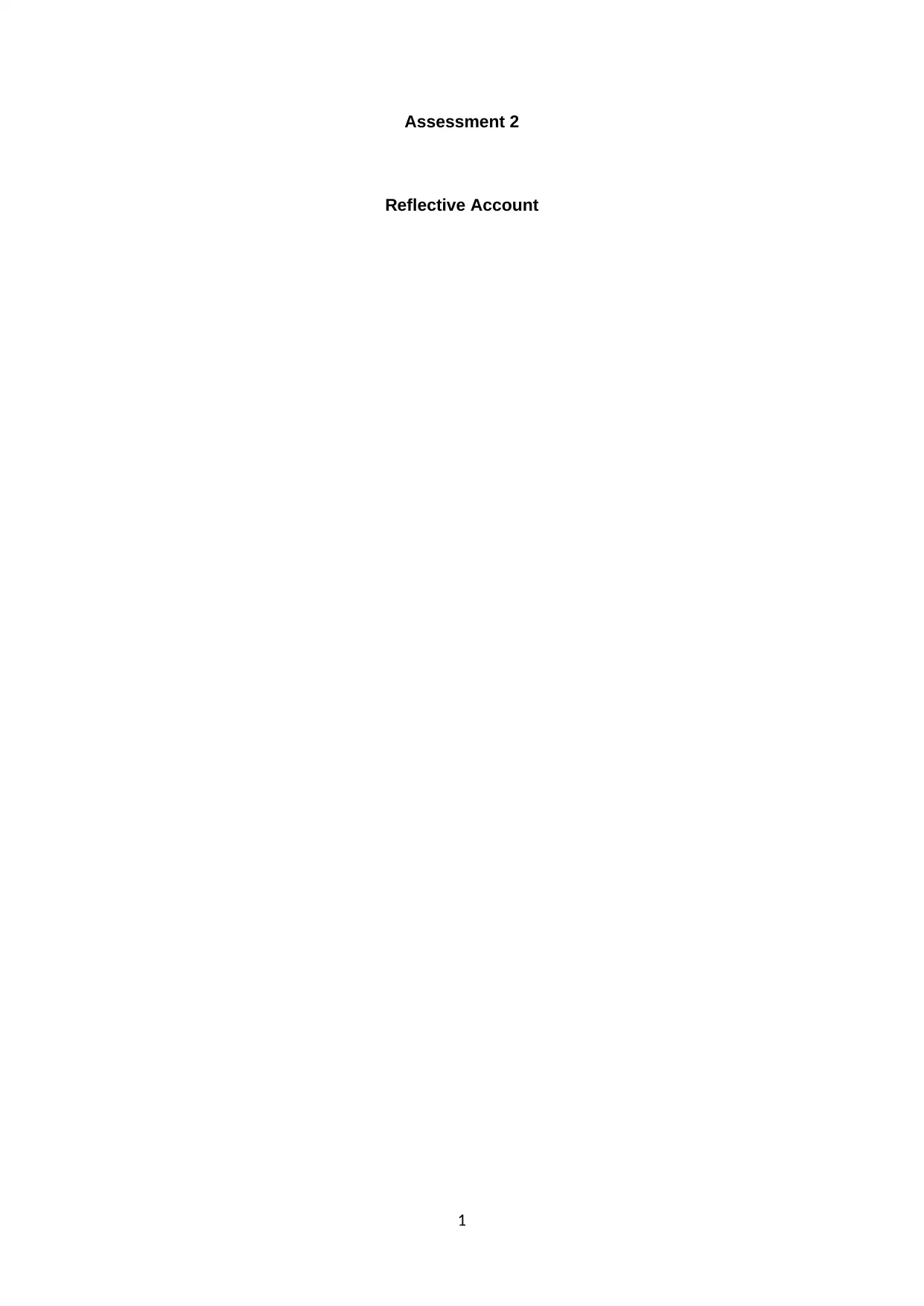
Assessment 2
Reflective Account
1
Reflective Account
1
Paraphrase This Document
Need a fresh take? Get an instant paraphrase of this document with our AI Paraphraser
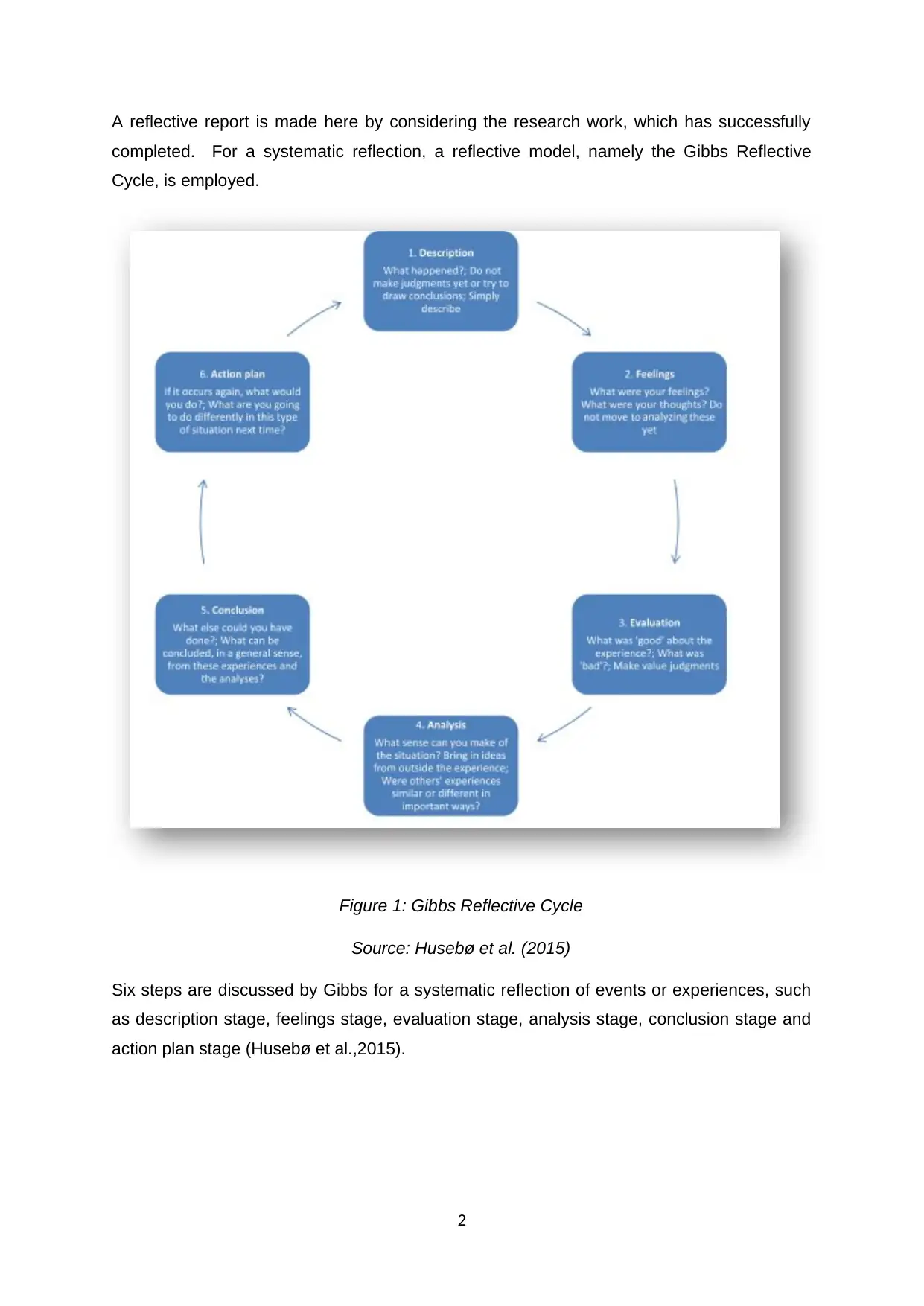
A reflective report is made here by considering the research work, which has successfully
completed. For a systematic reflection, a reflective model, namely the Gibbs Reflective
Cycle, is employed.
Figure 1: Gibbs Reflective Cycle
Source: Husebø et al. (2015)
Six steps are discussed by Gibbs for a systematic reflection of events or experiences, such
as description stage, feelings stage, evaluation stage, analysis stage, conclusion stage and
action plan stage (Husebø et al.,2015).
2
completed. For a systematic reflection, a reflective model, namely the Gibbs Reflective
Cycle, is employed.
Figure 1: Gibbs Reflective Cycle
Source: Husebø et al. (2015)
Six steps are discussed by Gibbs for a systematic reflection of events or experiences, such
as description stage, feelings stage, evaluation stage, analysis stage, conclusion stage and
action plan stage (Husebø et al.,2015).
2
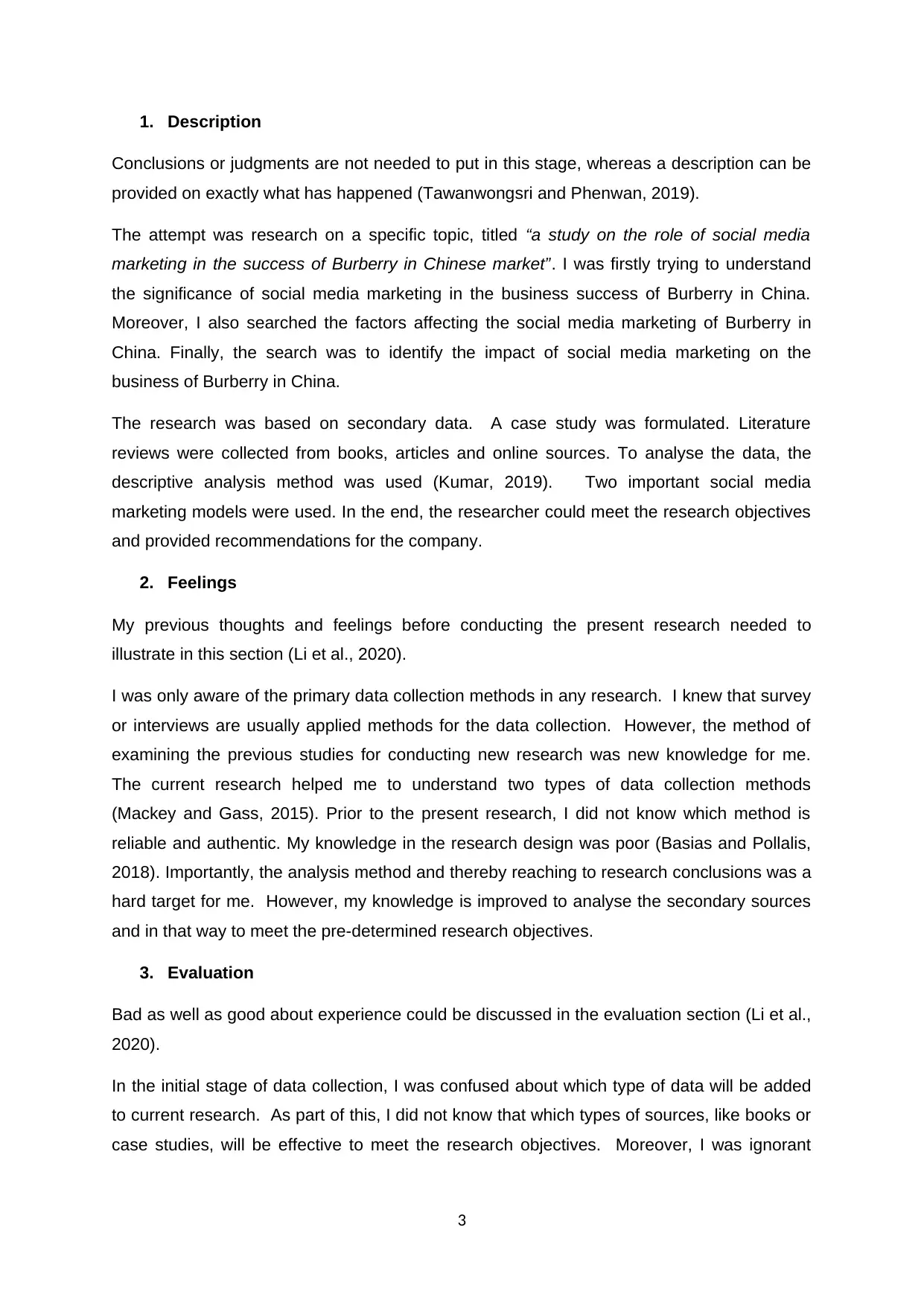
1. Description
Conclusions or judgments are not needed to put in this stage, whereas a description can be
provided on exactly what has happened (Tawanwongsri and Phenwan, 2019).
The attempt was research on a specific topic, titled “a study on the role of social media
marketing in the success of Burberry in Chinese market”. I was firstly trying to understand
the significance of social media marketing in the business success of Burberry in China.
Moreover, I also searched the factors affecting the social media marketing of Burberry in
China. Finally, the search was to identify the impact of social media marketing on the
business of Burberry in China.
The research was based on secondary data. A case study was formulated. Literature
reviews were collected from books, articles and online sources. To analyse the data, the
descriptive analysis method was used (Kumar, 2019). Two important social media
marketing models were used. In the end, the researcher could meet the research objectives
and provided recommendations for the company.
2. Feelings
My previous thoughts and feelings before conducting the present research needed to
illustrate in this section (Li et al., 2020).
I was only aware of the primary data collection methods in any research. I knew that survey
or interviews are usually applied methods for the data collection. However, the method of
examining the previous studies for conducting new research was new knowledge for me.
The current research helped me to understand two types of data collection methods
(Mackey and Gass, 2015). Prior to the present research, I did not know which method is
reliable and authentic. My knowledge in the research design was poor (Basias and Pollalis,
2018). Importantly, the analysis method and thereby reaching to research conclusions was a
hard target for me. However, my knowledge is improved to analyse the secondary sources
and in that way to meet the pre-determined research objectives.
3. Evaluation
Bad as well as good about experience could be discussed in the evaluation section (Li et al.,
2020).
In the initial stage of data collection, I was confused about which type of data will be added
to current research. As part of this, I did not know that which types of sources, like books or
case studies, will be effective to meet the research objectives. Moreover, I was ignorant
3
Conclusions or judgments are not needed to put in this stage, whereas a description can be
provided on exactly what has happened (Tawanwongsri and Phenwan, 2019).
The attempt was research on a specific topic, titled “a study on the role of social media
marketing in the success of Burberry in Chinese market”. I was firstly trying to understand
the significance of social media marketing in the business success of Burberry in China.
Moreover, I also searched the factors affecting the social media marketing of Burberry in
China. Finally, the search was to identify the impact of social media marketing on the
business of Burberry in China.
The research was based on secondary data. A case study was formulated. Literature
reviews were collected from books, articles and online sources. To analyse the data, the
descriptive analysis method was used (Kumar, 2019). Two important social media
marketing models were used. In the end, the researcher could meet the research objectives
and provided recommendations for the company.
2. Feelings
My previous thoughts and feelings before conducting the present research needed to
illustrate in this section (Li et al., 2020).
I was only aware of the primary data collection methods in any research. I knew that survey
or interviews are usually applied methods for the data collection. However, the method of
examining the previous studies for conducting new research was new knowledge for me.
The current research helped me to understand two types of data collection methods
(Mackey and Gass, 2015). Prior to the present research, I did not know which method is
reliable and authentic. My knowledge in the research design was poor (Basias and Pollalis,
2018). Importantly, the analysis method and thereby reaching to research conclusions was a
hard target for me. However, my knowledge is improved to analyse the secondary sources
and in that way to meet the pre-determined research objectives.
3. Evaluation
Bad as well as good about experience could be discussed in the evaluation section (Li et al.,
2020).
In the initial stage of data collection, I was confused about which type of data will be added
to current research. As part of this, I did not know that which types of sources, like books or
case studies, will be effective to meet the research objectives. Moreover, I was ignorant
3
⊘ This is a preview!⊘
Do you want full access?
Subscribe today to unlock all pages.

Trusted by 1+ million students worldwide
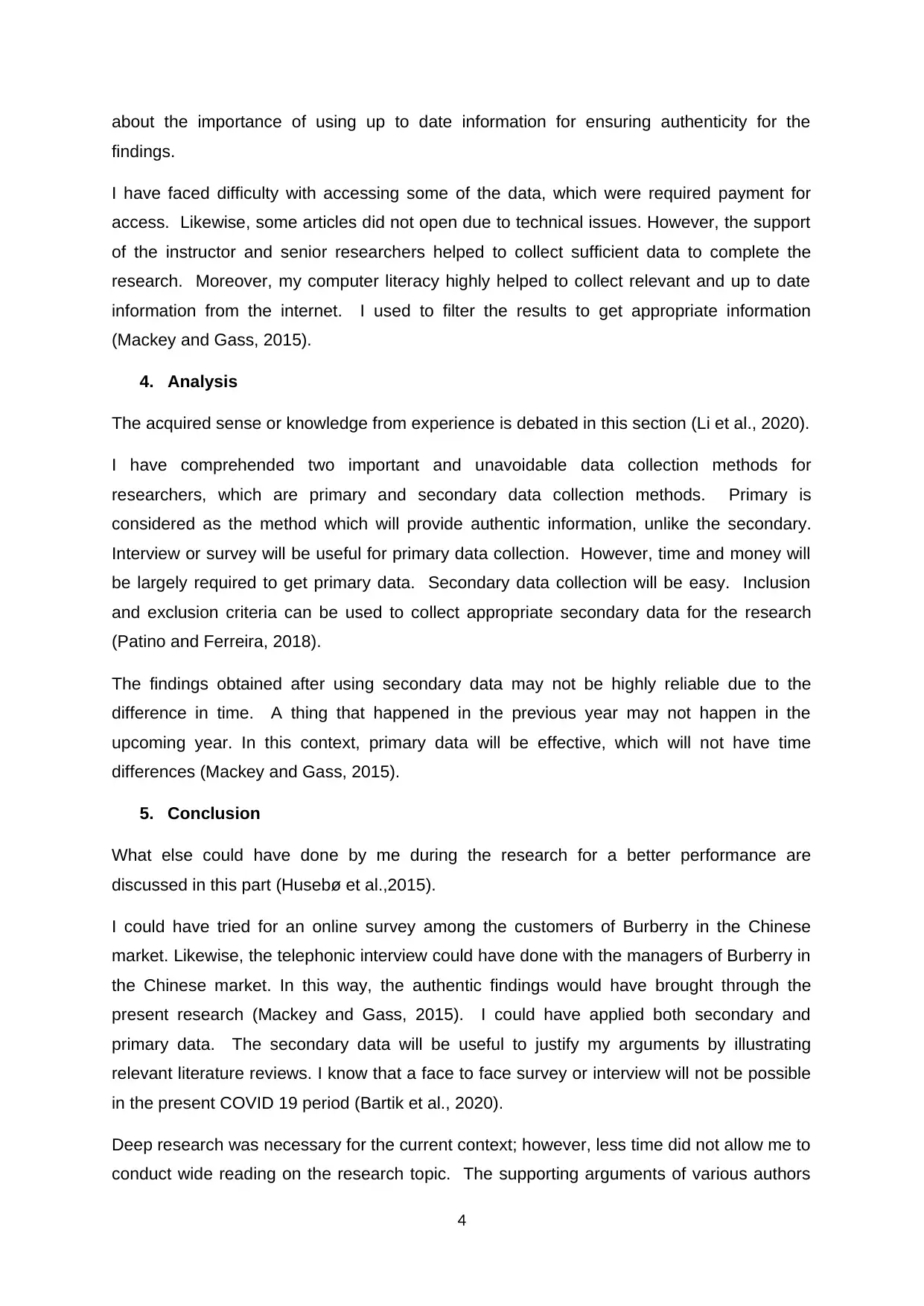
about the importance of using up to date information for ensuring authenticity for the
findings.
I have faced difficulty with accessing some of the data, which were required payment for
access. Likewise, some articles did not open due to technical issues. However, the support
of the instructor and senior researchers helped to collect sufficient data to complete the
research. Moreover, my computer literacy highly helped to collect relevant and up to date
information from the internet. I used to filter the results to get appropriate information
(Mackey and Gass, 2015).
4. Analysis
The acquired sense or knowledge from experience is debated in this section (Li et al., 2020).
I have comprehended two important and unavoidable data collection methods for
researchers, which are primary and secondary data collection methods. Primary is
considered as the method which will provide authentic information, unlike the secondary.
Interview or survey will be useful for primary data collection. However, time and money will
be largely required to get primary data. Secondary data collection will be easy. Inclusion
and exclusion criteria can be used to collect appropriate secondary data for the research
(Patino and Ferreira, 2018).
The findings obtained after using secondary data may not be highly reliable due to the
difference in time. A thing that happened in the previous year may not happen in the
upcoming year. In this context, primary data will be effective, which will not have time
differences (Mackey and Gass, 2015).
5. Conclusion
What else could have done by me during the research for a better performance are
discussed in this part (Husebø et al.,2015).
I could have tried for an online survey among the customers of Burberry in the Chinese
market. Likewise, the telephonic interview could have done with the managers of Burberry in
the Chinese market. In this way, the authentic findings would have brought through the
present research (Mackey and Gass, 2015). I could have applied both secondary and
primary data. The secondary data will be useful to justify my arguments by illustrating
relevant literature reviews. I know that a face to face survey or interview will not be possible
in the present COVID 19 period (Bartik et al., 2020).
Deep research was necessary for the current context; however, less time did not allow me to
conduct wide reading on the research topic. The supporting arguments of various authors
4
findings.
I have faced difficulty with accessing some of the data, which were required payment for
access. Likewise, some articles did not open due to technical issues. However, the support
of the instructor and senior researchers helped to collect sufficient data to complete the
research. Moreover, my computer literacy highly helped to collect relevant and up to date
information from the internet. I used to filter the results to get appropriate information
(Mackey and Gass, 2015).
4. Analysis
The acquired sense or knowledge from experience is debated in this section (Li et al., 2020).
I have comprehended two important and unavoidable data collection methods for
researchers, which are primary and secondary data collection methods. Primary is
considered as the method which will provide authentic information, unlike the secondary.
Interview or survey will be useful for primary data collection. However, time and money will
be largely required to get primary data. Secondary data collection will be easy. Inclusion
and exclusion criteria can be used to collect appropriate secondary data for the research
(Patino and Ferreira, 2018).
The findings obtained after using secondary data may not be highly reliable due to the
difference in time. A thing that happened in the previous year may not happen in the
upcoming year. In this context, primary data will be effective, which will not have time
differences (Mackey and Gass, 2015).
5. Conclusion
What else could have done by me during the research for a better performance are
discussed in this part (Husebø et al.,2015).
I could have tried for an online survey among the customers of Burberry in the Chinese
market. Likewise, the telephonic interview could have done with the managers of Burberry in
the Chinese market. In this way, the authentic findings would have brought through the
present research (Mackey and Gass, 2015). I could have applied both secondary and
primary data. The secondary data will be useful to justify my arguments by illustrating
relevant literature reviews. I know that a face to face survey or interview will not be possible
in the present COVID 19 period (Bartik et al., 2020).
Deep research was necessary for the current context; however, less time did not allow me to
conduct wide reading on the research topic. The supporting arguments of various authors
4
Paraphrase This Document
Need a fresh take? Get an instant paraphrase of this document with our AI Paraphraser
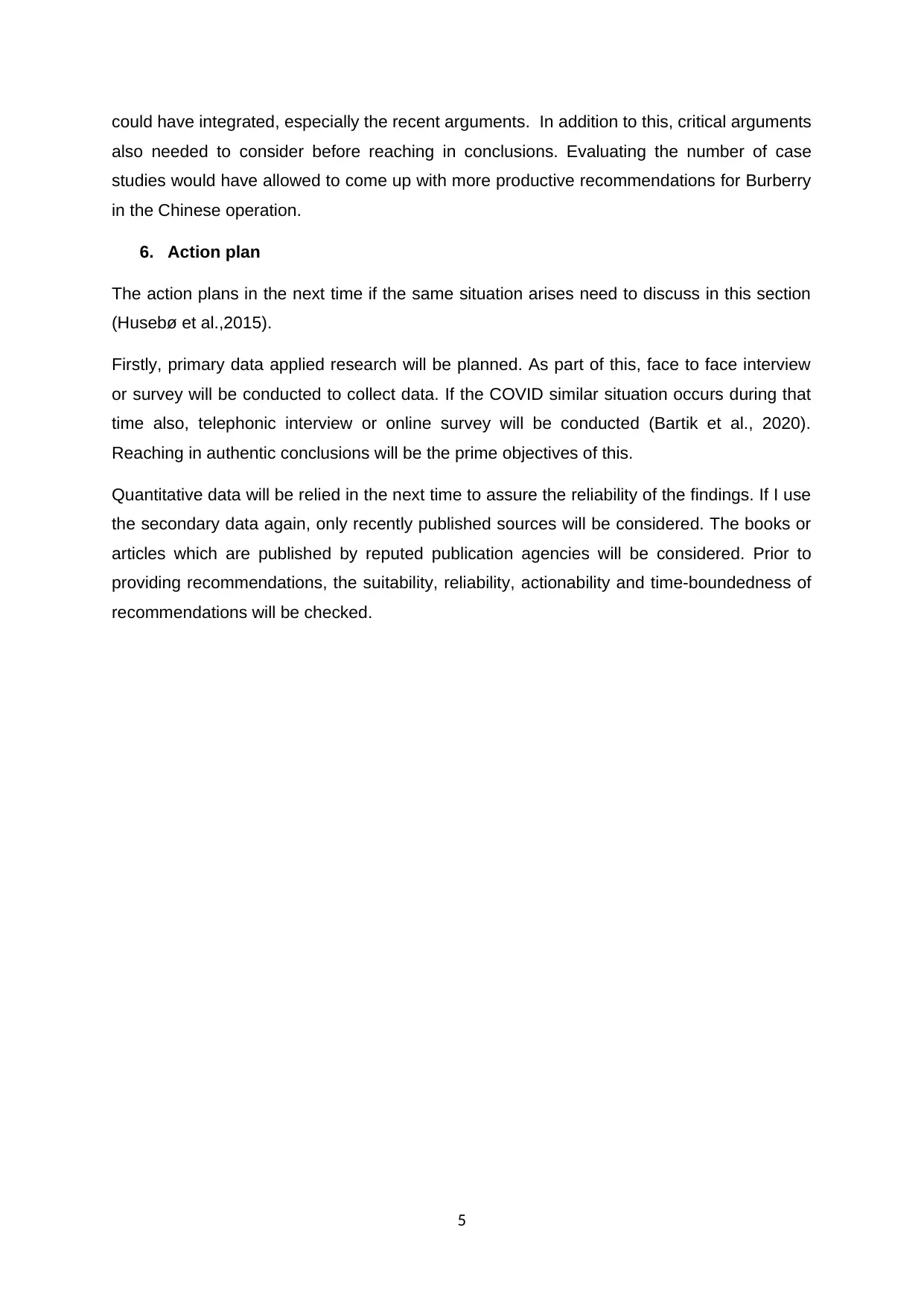
could have integrated, especially the recent arguments. In addition to this, critical arguments
also needed to consider before reaching in conclusions. Evaluating the number of case
studies would have allowed to come up with more productive recommendations for Burberry
in the Chinese operation.
6. Action plan
The action plans in the next time if the same situation arises need to discuss in this section
(Husebø et al.,2015).
Firstly, primary data applied research will be planned. As part of this, face to face interview
or survey will be conducted to collect data. If the COVID similar situation occurs during that
time also, telephonic interview or online survey will be conducted (Bartik et al., 2020).
Reaching in authentic conclusions will be the prime objectives of this.
Quantitative data will be relied in the next time to assure the reliability of the findings. If I use
the secondary data again, only recently published sources will be considered. The books or
articles which are published by reputed publication agencies will be considered. Prior to
providing recommendations, the suitability, reliability, actionability and time-boundedness of
recommendations will be checked.
5
also needed to consider before reaching in conclusions. Evaluating the number of case
studies would have allowed to come up with more productive recommendations for Burberry
in the Chinese operation.
6. Action plan
The action plans in the next time if the same situation arises need to discuss in this section
(Husebø et al.,2015).
Firstly, primary data applied research will be planned. As part of this, face to face interview
or survey will be conducted to collect data. If the COVID similar situation occurs during that
time also, telephonic interview or online survey will be conducted (Bartik et al., 2020).
Reaching in authentic conclusions will be the prime objectives of this.
Quantitative data will be relied in the next time to assure the reliability of the findings. If I use
the secondary data again, only recently published sources will be considered. The books or
articles which are published by reputed publication agencies will be considered. Prior to
providing recommendations, the suitability, reliability, actionability and time-boundedness of
recommendations will be checked.
5
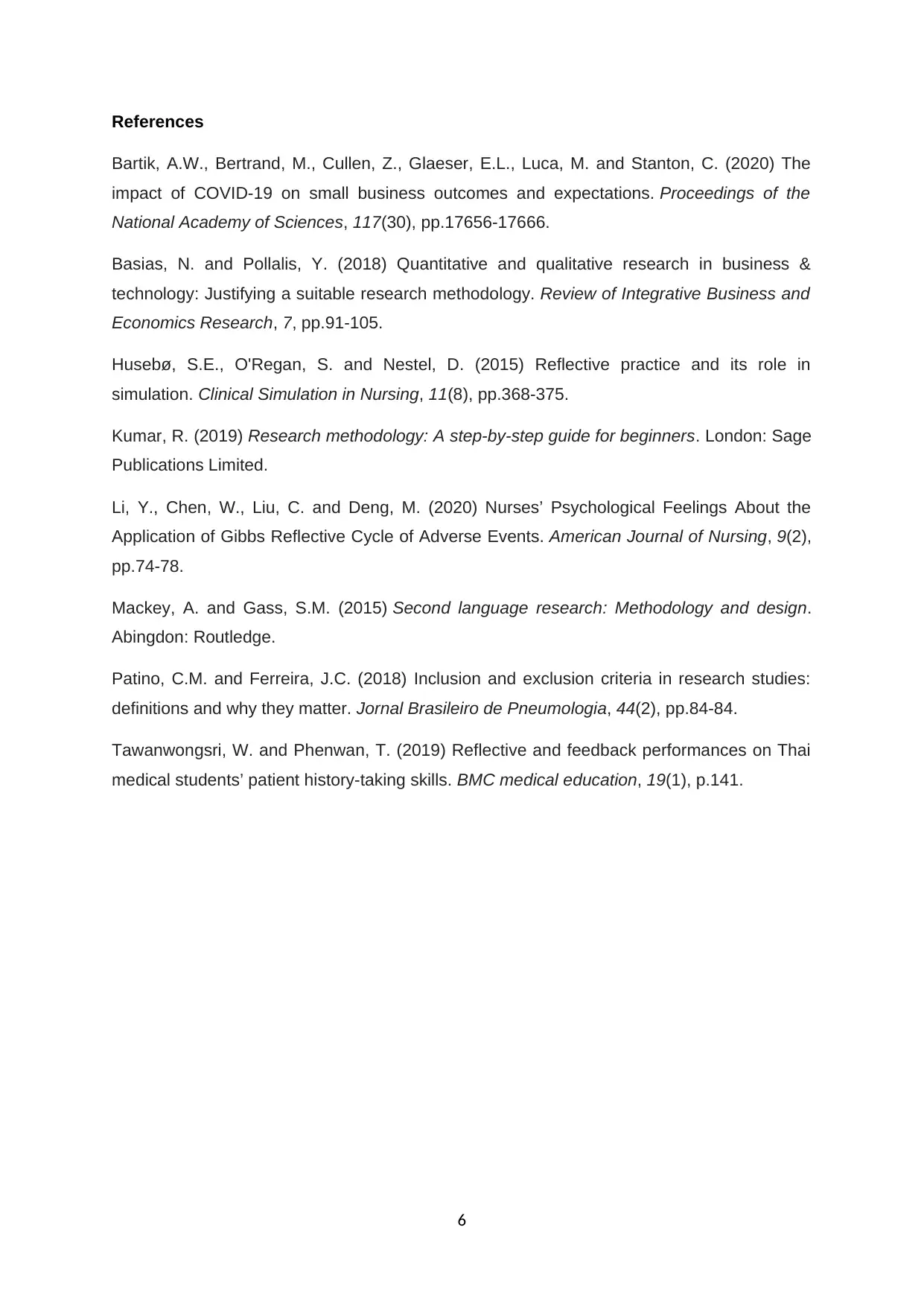
References
Bartik, A.W., Bertrand, M., Cullen, Z., Glaeser, E.L., Luca, M. and Stanton, C. (2020) The
impact of COVID-19 on small business outcomes and expectations. Proceedings of the
National Academy of Sciences, 117(30), pp.17656-17666.
Basias, N. and Pollalis, Y. (2018) Quantitative and qualitative research in business &
technology: Justifying a suitable research methodology. Review of Integrative Business and
Economics Research, 7, pp.91-105.
Husebø, S.E., O'Regan, S. and Nestel, D. (2015) Reflective practice and its role in
simulation. Clinical Simulation in Nursing, 11(8), pp.368-375.
Kumar, R. (2019) Research methodology: A step-by-step guide for beginners. London: Sage
Publications Limited.
Li, Y., Chen, W., Liu, C. and Deng, M. (2020) Nurses’ Psychological Feelings About the
Application of Gibbs Reflective Cycle of Adverse Events. American Journal of Nursing, 9(2),
pp.74-78.
Mackey, A. and Gass, S.M. (2015) Second language research: Methodology and design.
Abingdon: Routledge.
Patino, C.M. and Ferreira, J.C. (2018) Inclusion and exclusion criteria in research studies:
definitions and why they matter. Jornal Brasileiro de Pneumologia, 44(2), pp.84-84.
Tawanwongsri, W. and Phenwan, T. (2019) Reflective and feedback performances on Thai
medical students’ patient history-taking skills. BMC medical education, 19(1), p.141.
6
Bartik, A.W., Bertrand, M., Cullen, Z., Glaeser, E.L., Luca, M. and Stanton, C. (2020) The
impact of COVID-19 on small business outcomes and expectations. Proceedings of the
National Academy of Sciences, 117(30), pp.17656-17666.
Basias, N. and Pollalis, Y. (2018) Quantitative and qualitative research in business &
technology: Justifying a suitable research methodology. Review of Integrative Business and
Economics Research, 7, pp.91-105.
Husebø, S.E., O'Regan, S. and Nestel, D. (2015) Reflective practice and its role in
simulation. Clinical Simulation in Nursing, 11(8), pp.368-375.
Kumar, R. (2019) Research methodology: A step-by-step guide for beginners. London: Sage
Publications Limited.
Li, Y., Chen, W., Liu, C. and Deng, M. (2020) Nurses’ Psychological Feelings About the
Application of Gibbs Reflective Cycle of Adverse Events. American Journal of Nursing, 9(2),
pp.74-78.
Mackey, A. and Gass, S.M. (2015) Second language research: Methodology and design.
Abingdon: Routledge.
Patino, C.M. and Ferreira, J.C. (2018) Inclusion and exclusion criteria in research studies:
definitions and why they matter. Jornal Brasileiro de Pneumologia, 44(2), pp.84-84.
Tawanwongsri, W. and Phenwan, T. (2019) Reflective and feedback performances on Thai
medical students’ patient history-taking skills. BMC medical education, 19(1), p.141.
6
⊘ This is a preview!⊘
Do you want full access?
Subscribe today to unlock all pages.

Trusted by 1+ million students worldwide
1 out of 6
Related Documents
Your All-in-One AI-Powered Toolkit for Academic Success.
+13062052269
info@desklib.com
Available 24*7 on WhatsApp / Email
![[object Object]](/_next/static/media/star-bottom.7253800d.svg)
Unlock your academic potential
Copyright © 2020–2025 A2Z Services. All Rights Reserved. Developed and managed by ZUCOL.




